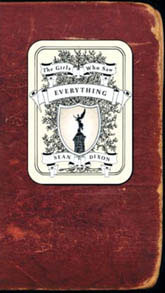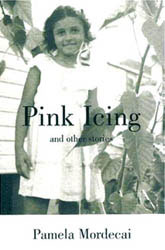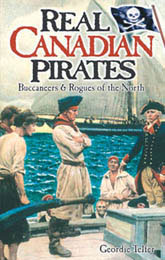
The Girls Who Saw Everything
trade paperback $21.95

Pink Icing and Other Stories
trade paperback $21.95

Real Canadian Pirates: Buccaneers and Rogues of the North
trade paperback $18.95
September 2007
A bizarre, annoying, postmodern delight
The Girls Who Saw Everything not has only a great title, but a great opening:
March 18th, 2003, 7:08 P.M.
When Runner Coghill fell through the ceiling, she interrupted what we can only call a domestic quarrel.
You—ve got to give a book like that a shot. And Toronto playwright Sean Dixon's first novel pays off the effort more than most such.
It's very clever, in a postmodern kind of way. Quite aware of itself as a published work, referring to its pretend authors (purportedly two of the girls —who saw everything—) and to its readers who are often addressed directly. Full of asides, comments on itself. Even footnotes correcting itself.
And all quite clever. Did I say that before?[1]
Beguiling story line too. A group calls itself the Lacuna Cabal Montreal Young Women's Book Club, being based in Montreal and reading books. It also has three males in its circle. But, even stranger, more than discussing literature, they act it out.
A (female) member brings in what she calls the world's first book for discussion. Actually a story written in cuneiform on stone tablets. She calls it He Who Saw Everything, but we soon learn it is actually Gilgamesh, the ancient Babylonian epic that actually is often considered the first book ever.
Acting it out involves some rather violent escapades.
Not to give away the plot — but then it's not a plot that can be given away, it becomes so bizarre and difficult to explain, involving deaths from strange diseases, ghosts from the underworld (real or imagined, I'm not sure), a robot that leads the team on a worldwide quest, and the war in Iraq, no less.
But this is an unfair summary, dear reader, because the story isn't as hard to follow or as incredible as that may sound.
Dixon's style is both charming and annoying. Like other playwrights-turned-novelists, such as Timothy Findley and Ann-Marie MacDonald (who is referenced several times along with many other Canadian writers), he eschews the intense characterization and place-setting, or even interior monologues, of mainstream novelists to present his quirky characters entirely through their quirky behaviour and through lots of quirky, disjointed dialogue. Their motivations are—at least initially—obscure. They seem to do things and things seem to do to them for no particular reason. Only toward the end of the novel do their personalities start to gel in the reader's mind.
Nor do the fantastic elements inserted every now and then help. I know magical realism is all the rage, but when we sense the author can arbitrarily throw in any plot device, do we really care any more what happens?
Sooo pre-modern of me to be concerned about —what happens—, I know.
But despite this interest-destroying arbitrariness, The Girls Who Saw Everything is a hoot.
I wasn't surprised to learn in an afterword that it started as a stage play. I could see it as an offbeat indie film some day.
[1] Yes, I did.
Royal story all downhill after the title
Jamaican-born and Toronto-residing Pamela Mordecai has apparently published over 30 books—including textbooks, children's books, poetry and anthologies of Caribbean writing—although I'm embarrassed to say this is the first I've read.
Good place to start though. Reading Pink Icing is like discovering a fresh young voice in fiction. The stories of everyday life in the islands, often seen through the eyes of school-age girls, are simple, sometimes to the point of banality, with the occasional tragedy thrown in. A strange man comes to town and has the audacity to drink directly from the local watering pipe. A new girl shows up at the local high school. A young trouble-making boy helps a local Chinese storekeeper who has fallen down a hill. A body is found on the edge of a garden of medicinal plants tended by a grandfather.
Yet the stories are both powerful and enchanting. Partly because of the naive perspective. We know more than the narrators or central figures what the medicinal plants really are, or what's really happening with the adults who disappear or become sick or are taken away. We are charmed by the fantasies spun by young minds to explain the mysterious world of grownups, as well as feel the pangs of too-familiar reality as we cannot help but read between the lines.
And much of the enchantment comes from Mordecai's writing style. Not just because her language is that of West Indian villagers—although that itself is delightful. It's never patronizing, as if making fun of unsophisticated folks, but presented as a creative enterprise with wondrous turns of phrase that nail what's being discussed better than our standard British grammar. After a brief initial wrench, the reader easily swings into its rhythms and might find himself using it in his own everyday life.
But more importantly, Mordecai has a knack for structuring a story in unexpected ways, so that one is never sure exactly what is about to transpire but afterwards feels it was just right. Sometimes the story is abruptly cut short, sometimes it goes on past the immediate slice-of-life depiction that one thinks is the point to enter a wider space and a greater drama. Sometimes there seems no overt point at all to be described, but it feels as though we—ve discovered something.
Pink Icing shows Mordecai, whatever her other publishing accomplishments, has the short-story writer's very particular talents and also the vision to take the form to another place.
Our colourful, disreputable history
Forget Pirates of the Caribbean—we have our own rogues of the sea in the True North. Stage actor and director Geordie Telfer swells our nationalistic pride with tales of —real Canadian pirates—, like Black Bart, Gun Powder Gertie, and the —Patriot Pirate of the Thousand Islands—, the otherwise boringly named Bill Johnston.
Actually, come to think of it, quite a few of these rogues had common, unmovie-like monikers: Peter Easton, Henry Mainwarring, and Ned and Margaret Jordan.
And quite a few of them were involved in Canadian politics and affected our history beyond their contributions to sea legends. They often became pirates in the first place at the behest of, or at least with a blind eye from, local governments who used them in their fight with other countries or colonies. They often rubbed shoulders or did business with historical figures who are studied in our schools.
Telfer brings these disreputable but colourful figures alive, in ways that would drive serious historians crazy. He creates narratives to depict their exploits, putting words in their mouths and thoughts in their heads—all without indicating any sources to support such licence.
But leave citations, footnotes and issues of piddling accuracy to the academics to follow up with. At the moment, it's interesting and fun to get a rough idea of a part of our history most of us likely knew nothing about. And it's obvious the author has done plenty of research to come up with the details he uses in his narratives to at least lend an air of credibility to these not-so-tall tales.
Real Canadian pirates? I'm not sure. But I'd like to think so.
— Eric McMillan

